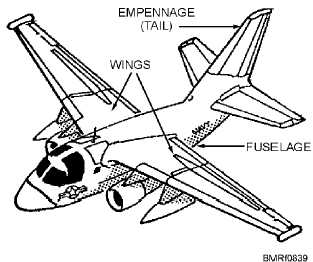takeoff or to slow the aircraft in flight or landings;
ailerons that control the roll or bank of the aircraft; and
trim tabs used to aerodynamically unload the control
surfaces to relieve some of the pilot’s work. On the
leading (front) edge of the wing may be found auxiliary
lifting devices, resembling flaps, which are used to
increase camber (curvature) of the wing for added lift on
takeoff. Most Navy jet aircraft carry their bomb loads on
pylons (called stations) under the wings and, in some
cases, under the fuselage. Some jets have missile
stations on the sides of the fuselage. Fuel cells are
located in the wings; additional external tanks can be
fitted for extra range. Larger jets may have their engines
slung beneath the wings in pods. Some low-wing
aircraft have their main landing gear retract into the
wings, while the nose wheel retracts into the fuselage.
On most high-wing aircraft all gear retracts into the
fuselage.
EMPENNAGE.—The empennage consists of the
stabilizing fins mounted on the tail section of the
fuselage. These include the vertical stabilizer on which
is generally mounted the rudder that is used to control
yaw, or direction of the nose about the vertical axis; and
the horizontal stabilizer, on the trailing edge of which
are the elevators that determine the pitch (climb or dive).
Some supersonic aircraft may have a full delta wing. In
that case, there is no horizontal stabilizer and the
elevators and ailerons are combined into control
surfaces called elevons.
In aircraft with internally mounted jet engines,
exhausts normally are in the tail. High-performance jets
have afterburners that give additional thrust at the cost
of greatly increased fuel consumption.
Rudder, ailerons, and elevators are collectively
grouped as control surfaces. The “stick” or a similar
device in the cockpit controls these surfaces, while foot
pedals control the rudder. On high-performance
aircraft, aerodynamic pressures on these surfaces
become too great for a pilot to overcome manually;
hence, all high-speed models today have power-assisted
controls.
Rotary-Wing Aircraft Nomenclature
The aerodynamics of rotary-wing aircraft (fig.
8-40) are considerably more complex than those of
fixed-wing aircraft. A helicopter essentially consists of
a fuselage, main rotor or rotors, and often a tail rotor.
FUSELAGE.—As in fixed-wing aircraft, the
fuselage contains the cockpit and cabin.
M A I N ROTO R . — T h e m a i n r o t o r i s t h e
approximate equivalent of the wing of a fixed-wing
aircraft. Each rotor blade is an airfoil, like a wing, and
the lift is generated by the rotation of the assembly,
which creates a flow of air over the blades.
A helicopter is lifted into the air by the aerodynamic
forces on the rotor and not pushed up by the downwash.
Some helicopters have twin rotors in tandem at either
end of the fuselage; but most have a single, main rotor
with a tail rotor mounted at right angles. A few have
tandem intermeshing rotors.
TAIL ROTOR.—The tail rotor is used for
directional control and stability. It is mounted at right
angles to the main rotor to counteract the torque of that
system. By varying the pitch of the tail rotor blades, the
pilot controls yaw.
Helicopter engines are connected to the rotor
shaft(s) by a transmission, which may be disengaged.
That permits the engine(s) to be operated on the ground
without engaging the rotor system and also permits a
mode of flight known as autorotation. If the engines
should stop while in flight, they can be disengaged; the
freewheeling action of the rotor will allow a slower
descent.
8-33
Figure 8-39. Fixed-wing aircraft.
Student Notes:



